
23 Feb Cholinergic basal forebrain degeneration due to OSA exacerbates pathology of Alzheimer’s disease in a mouse model
It is theorised that Alzheimer’s Disease (AD) develops when the cleavage of amyloid precursor protein (APP) is altered to favour the production of the neurotoxic peptide amyloid-beta (Aβ). Aβ load is associated with basal forebrain atrophy and dysfunction, however, Aβ is not solely responsible for inducing cognitive decline.
Obstructive sleep apnoea, the most prevalent form of sleep-disordered breathing (SDB), is a strong risk factor for developing AD and associated with an earlier age onset of the disease, more rapid cognitive decline and an increased Aβ burden. It is thought that sleep fragmentation, due to repetitive EEG arousals, slows the clearance of Aβ from the brain interstitial space through the glymphatic system. Interruption of the glymphatic clearance in sleep results in increased Aβ plaque load and inflammation. GABAergic basal forebrain neurons elicit an arousal in response to SDB and hypercapnia SDB-induced sleep disruption and can contribute to cognitive impairment and eventually dementia, as sleep is fundamental for learning and memory consolidation. Cholinergic basal forebrain (cBF) neurons project to the neocortex, and are responsible for regulating cognitive processes, including spatial navigation and associative learning. Significantly, these are the first to show degeneration in AD. Cognitive decline in patients with OSA is linearly correlated with hypoxemia.
The study by Qian, L., Rawashdeh, O., Kasas, L. et al. modelled SDB in genetically susceptible AD mice and demonstrated that cholinergic basal forebrain (cBF) neurodegeneration and cognitive impairment is induced by intermittent hypoxia, and SDB exacerbates pathological features such as plaque load and inflammation, that contribute to AD progression. Importantly, it was found that sleep deprivation impaired working memory of mice, but it did not induce cholinergic basal forebrain (cBF) neuronal dysfunction nor exacerbated Aβ accumulation. Fluctuating hypoxia, which is characteristic of SBD, was found to be a significant causal factor to developing AD in humans. Chronic hypoxia and intermittent hypoxia induce different cBF outcomes. Chronic hypoxic conditions result in Hypoxia-inducible factor 1 alpha (HIF1α) mRNA transcriptional pathways that downregulate HIF1α after several hours, whereas intermittent hypoxia does not activate the same pathways and results in increased HIF1α mRNA levels.
Chronic exposure to hypoxia results in increased HIF1α triggers the transcription of genes to produce vascular endothelin growth factor, which improves cerebral blood flow and opposes the toxic effects of hypoxia. In contrast, intermittent hypoxia with prolonged and persistent HIF1α activation triggers increased expression of reactive oxygen species-generating NOX proteins, and is linked to cell death. The extent of HIF1α downstream repression or increased gene expression is depend on levels of exposure to chronic or intermittent hypoxia.
This study models the correlation between fluctuating hypoxemia, a characteristic feature of OSA, and reperfusion of the brain is a key mechanism responsible for cBF degeneration.
Qian, L., Rawashdeh, O., Kasas, L. et al. Cholinergic basal forebrain degeneration due to sleep-disordered breathing exacerbates pathology in a mouse model of Alzheimer’s disease. Nature Communications 13:6543 (2022). https://doi.org/10.1038/s41467-022-33624-y

